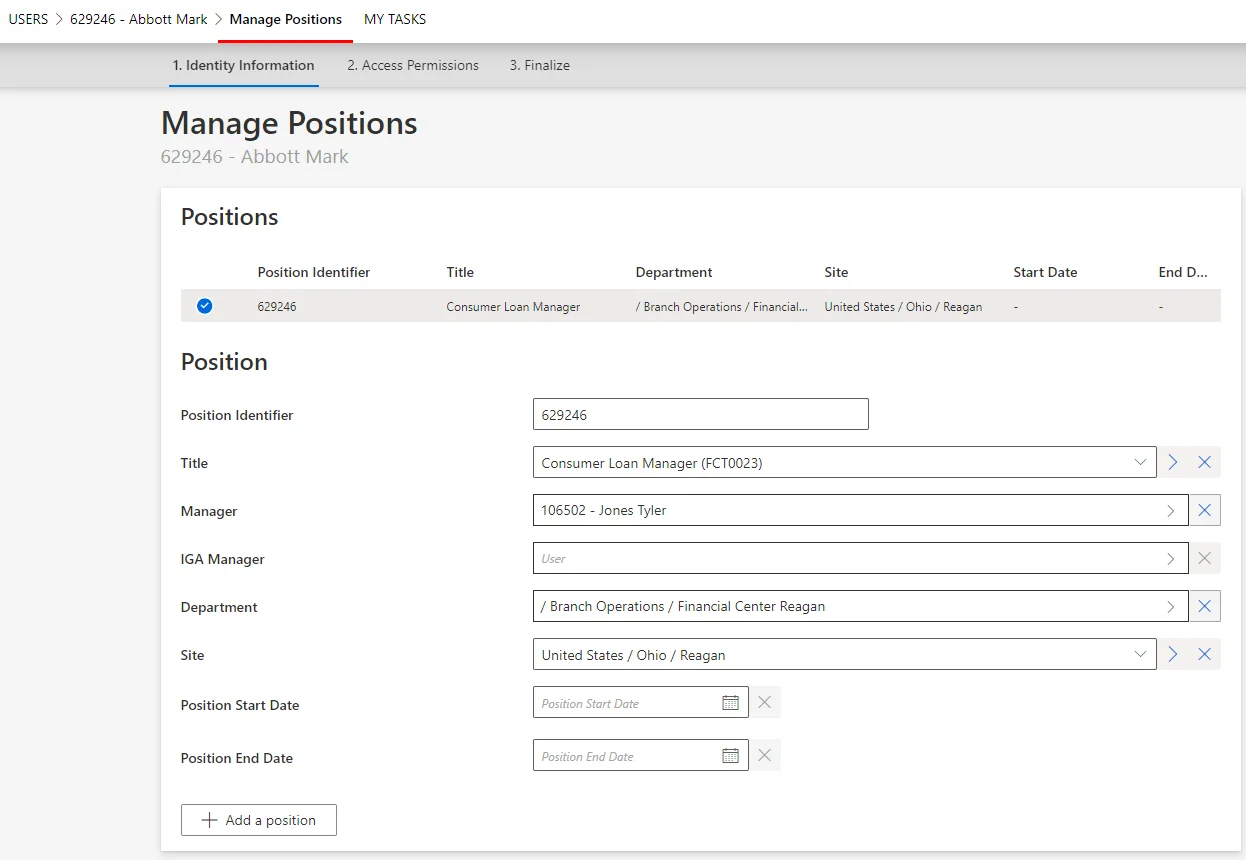For Resource Update (Multi Records)
This section guides you through the procedure for the creation of a workflow to update an existing resource through its several records.
Declare a Workflow
This workflow is made of three activities:
ActionWithRefine: sends the resource's records update request with a possibility of delegation.ReviewWithFeedback: reviews the update request with the possibility of getting feedback from another user.Persist: saves the collected data and triggers provisioning.
The example below creates a workflow to update the records of an existing user:
<Workflow Identifier="Directory_User_UpdateSeveralRecords" DisplayName_L1="User - Manage positions" VariablesType="Workflow_Directory_User"> <Activity Identifier="Request" DisplayName_L1="Request" Template="ActionWithRefine" /> <Activity Identifier="Review" DisplayName_L1="Review" Template="ReviewWithFeedback" /> <Activity Identifier="Persist" DisplayName_L1="Commit" Template="Persist" /></Workflow>
Create Forms
The XML configuration below represents the creation of a form that defines the elements to display in the workflow.
Here we create three structured forms, all to be called in our final workflow form:
First form for the user's record data, shared with all records:
<Form Identifier="Directory_User_UpdateSeveralRecords_Shared" EntityType="Directory_UserRecord"> <Control DisplayName_L1="Contract" OutputType="LayoutFieldset"> <Control Binding="ContractStartDate" /> <Control Binding="ContractEndDate" AddedMinutes="1440" /> </Control></Form>
Second form for the user's record data, specific to each record individually:
<Form Identifier="Directory_User_UpdateSeveralRecords_Base" EntityType="Workflow_Directory_User"> <Control OutputType="LayoutContainer" EntityType="Directory_UserRecord"> <Control DisplayName_L1="Position" OutputType="LayoutFieldset"> <Control Binding="Title" IsRequired="true" /> <Control Binding="Department" /> <Control Binding="Site" DefaultValueBinding="Department.Manager.MainRecord.Site" /> <Control Binding="StartDate" /> <Control Binding="EndDate" /> </Control> </Control></Form>
Link the Forms to the Workflow
After creating a workflow with given activities, it is necessary to create the form to be displayed
when launching the workflow. It has the type corresponding to a resource's update with several
records, i.e. WorkflowUpdateSeveralRecordEntityForm and it must specify the workflow's context
(the entity type of the involved resources, the main property, the activity when the form is called,
etc.
see more details):
<WorkflowUpdateSeveralRecordsEntityForm RecordFilter="CurrentAndFuture" Identifier="Directory_User_UpdateSeveralRecords" EntityType="Workflow_Directory_User" MainProperty="Workflow_Directory_User:Directory_User" RecordProperty="Directory_User:Records" WorkflowRequestType="Self" Activity="Directory_User_UpdateSeveralRecords:Request" FormTitle_L1="Manage positions" RecordTable="Directory_User_UpdateSeveralRecords"></WorkflowUpdateSeveralRecordsEntityForm>
WorkflowUpdateSeveralRecordEntityForm displays a date picker for the end of transition, to
schedule the record replacement.
A WorkflowUpdateSeveralRecordEntityForm requires the following child elements:
MainControlthat defines user's data;
<WorkflowUpdateSeveralRecordsEntityForm RecordFilter="CurrentAndFuture" Identifier="Directory_User_UpdateSeveralRecords" EntityType="Workflow_Directory_User" MainProperty="Workflow_Directory_User:Directory_User" RecordProperty="Directory_User:Records" WorkflowRequestType="Self" Activity="Directory_User_UpdateSeveralRecords:Request" FormTitle_L1="Manage positions" RecordTable="Directory_User_UpdateSeveralRecords">
<MainControl OutputType="LayoutContainer" />
</WorkflowUpdateSeveralRecordsEntityForm>
The MainControl attribute is here an empty container, because it is a mandatory attribute that is
not involved in the changes of this workflow.
RecordControlthat defines the record data shared with all records and calls the firstform created previously;
<WorkflowUpdateSeveralRecordsEntityForm RecordFilter="CurrentAndFuture" Identifier="Directory_User_UpdateSeveralRecords" EntityType="Workflow_Directory_User" MainProperty="Workflow_Directory_User:Directory_User" RecordProperty="Directory_User:Records" WorkflowRequestType="Self" Activity="Directory_User_UpdateSeveralRecords:Request" FormTitle_L1="Manage positions" RecordTable="Directory_User_UpdateSeveralRecords"> <MainControl OutputType="LayoutContainer"/>
<RecordControl OutputType="TransformImport" EmbeddedForm="Directory_User_UpdateSeveralRecords_Shared" />
</WorkflowUpdateSeveralRecordsEntityForm>
RecordUniqueItemControlthat defines the record data specific to each record individually, and calls the secondform created previously;
<WorkflowUpdateSeveralRecordsEntityForm RecordFilter="CurrentAndFuture" Identifier="Directory_User_UpdateSeveralRecords" EntityType="Workflow_Directory_User" MainProperty="Workflow_Directory_User:Directory_User" RecordProperty="Directory_User:Records" WorkflowRequestType="Self" Activity="Directory_User_UpdateSeveralRecords:Request" FormTitle_L1="Manage positions" RecordTable="Directory_User_UpdateSeveralRecords"> <MainControl OutputType="LayoutContainer"/> <RecordControl OutputType="TransformImport" EmbeddedForm="Directory_User_UpdateSeveralRecords_Shared"/>
<RecordUniqueItemControl OutputType="TransformImport" EmbeddedForm="Directory_User_UpdateSeveralRecords_Base" />
</WorkflowUpdateSeveralRecordsEntityForm>
RecordSlaveControlthat copies an existing record to be the base, i.e. pre-fill the fields, for the update of record data specific to each record individually. Thus it calls the same form asRecordUniqueItemControl.
<WorkflowUpdateSeveralRecordsEntityForm RecordFilter="CurrentAndFuture" Identifier="Directory_User_UpdateSeveralRecords" EntityType="Workflow_Directory_User" MainProperty="Workflow_Directory_User:Directory_User" RecordProperty="Directory_User:Records" WorkflowRequestType="Self" Activity="Directory_User_UpdateSeveralRecords:Request" FormTitle_L1="Manage positions" RecordTable="Directory_User_UpdateSeveralRecords"> <MainControl OutputType="LayoutContainer"/> <RecordControl OutputType="TransformImport" EmbeddedForm="Directory_User_UpdateSeveralRecords_Shared"/> <RecordUniqueItemControl OutputType="TransformImport" EmbeddedForm="Directory_User_UpdateSeveralRecords_Base" />
<RecordSlaveControl OutputType="TransformImport" EmbeddedForm="Directory_User_UpdateSeveralRecords_Base" />
</WorkflowUpdateSeveralRecordsEntityForm>
RecordSlaveUniqueItemControlthat copies an existing record to be the base, i.e. pre-fill the fields, for the update of record data shared with all records. Thus it calls the same form asRecordControl.
<WorkflowUpdateSeveralRecordsEntityForm RecordFilter="CurrentAndFuture" Identifier="Directory_User_UpdateSeveralRecords" EntityType="Workflow_Directory_User" MainProperty="Workflow_Directory_User:Directory_User" RecordProperty="Directory_User:Records" WorkflowRequestType="Self" Activity="Directory_User_UpdateSeveralRecords:Request" FormTitle_L1="Manage positions" RecordTable="Directory_User_UpdateSeveralRecords"> <MainControl OutputType="LayoutContainer"/> <RecordControl OutputType="TransformImport" EmbeddedForm="Directory_User_UpdateSeveralRecords_Shared"/> <RecordUniqueItemControl OutputType="TransformImport" EmbeddedForm="Directory_User_UpdateSeveralRecords_Base" /> <RecordSlaveControl OutputType="TransformImport" EmbeddedForm="Directory_User_UpdateSeveralRecords_Base" />
<RecordSlaveUniqueItemControl OutputType="TransformImport" EmbeddedForm="Directory_User_UpdateSeveralRecords_Shared" />
</WorkflowUpdateSeveralRecordsEntityForm>
The RecordSlaveControl attribute calls here the same form as RecordUniqueControl, because it
copies part of the main record to pre-fill the fields of RecordUniqueControl.

Assign the Right Permissions
Some profiles must get specific permissions so that the workflow is visible and usable by the right users. Read about workflows' permissions.
Below is an example of an access control rule where the Administrator profile gets the permissions
for the whole update request from the previously created workflow:
<AccessControlRule Profile="Administrator" EntityType="Workflow_Directory_User" Identifier="Administrator_Workflows_Directory_User_*" DisplayName_L1="Administrator_Workflows_Directory_User_*"> <Entry Permission="/Custom/Workflows/Directory_User_UpdateSeveralRecords/Request/ActionPending" CanExecute="true" /> <Entry Permission="/Custom/Workflows/Directory_User_UpdateSeveralRecords/Request/RefinePending" CanExecute="true" /> <Entry Permission="/Custom/Workflows/Directory_User_UpdateSeveralRecords/Request/Aborted" CanExecute="true" /> <Entry Permission="/Custom/Workflows/Directory_User_UpdateSeveralRecords/Request/Purged" CanExecute="true" /> <Entry Permission="/Custom/Workflows/Directory_User_UpdateSeveralRecords/Review/ReviewPending" CanExecute="true" /> <Entry Permission="/Custom/Workflows/Directory_User_UpdateSeveralRecords/Review/RefinePending" CanExecute="true" /> <Entry Permission="/Custom/Workflows/Directory_User_UpdateSeveralRecords/Review/Aborted" CanExecute="true" /> <Entry Permission="/Custom/Workflows/Directory_User_UpdateSeveralRecords/Review/Purged" CanExecute="true" /></AccessControlRule>
Create Menu Items in the UI
Menu items must be defined to make the workflow accessible in the UI.
Updating an existing resource, this workflow manages one given resource at a time. Hence an interesting location for this workflow could be the individual view page of users.

To create a menu item here for the new workflow, you can add the following XML configuration to the existing menu items list:
<MenuItem Identifier="Menu_Directory_User" DisplayName_L1="Menu"> <MenuItem Identifier="Menu_Directory_User_Changes" DisplayName_L1="Actions"> <MenuItem Identifier="Menu_Directory_User_Changes_Update" DisplayName_L1="Section"> ...
<MenuItem Identifier="Menu_Directory_User_Changes_ManagePositions" DisplayName_L1="Manage Positions" IconCode="Edit" Workflow="Directory_User_UpdateSeveralRecords" />
</MenuItem> </MenuItem></MenuItem>
Add Aspects
For each workflow, it is possible to add aspects according to the workflow's purpose.
Homonym Detection (Optional)
To perform a homonymy check on a workflow and thus prevent user duplicates, read how to configure a homonym detection.
When using records, the homonym detection displays the list of records and not just the list of users.
Customize the Display Table (Optional)
To configure a display table different from the default one provided by Usercube, read how to configure a display table.